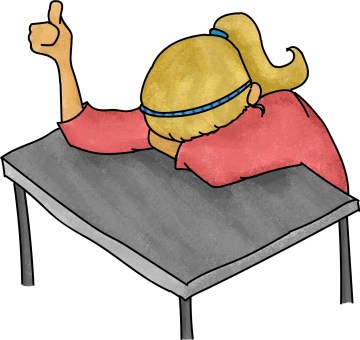What it is: A grade school game played in a classroom, a quiet game to keep a class occupied.
Best for: A class at school.
What you need:
- The game works best when players have desks or tables to sit at. Other than that, you don’t need anything!
How to play: (Okay, this is reaching way back into my grade school memories for this one…) Heads up, seven up is a game often played in classrooms as a reward or to fill extra down time. It’s quiet and calm (great for teachers!) but fun for the kids.
To start, choose seven children. We’ll call them the Seven. They move to the front of the room and stand, facing the class. The rest of the class sit in their desks. Then the teacher (or whoever’s in charge) calls out, “Heads down, thumbs up!”
All the students sitting in their desks put their heads down and put one thumb in the air, like this:

They close their eyes and cover their faces so they can’t see. I seem to always remember the lights being off at this point, too, but maybe that’s unnecessary. Just tell kids not to peek.
Once all the students in their desks have their heads down and their thumbs up, the teacher signals to the Seven, who then quietly walk among the class. Each of the Seven picks one student sitting down and quietly touches their outstretched thumb. The student then tucks their thumb into their fist but continues waiting silently with eyes closed.
Once the Seven have all touched a thumb, they stand back at the front of the classroom. The teacher announces, “Heads up, seven up!” and all of the students in the class can raise their heads and open their eyes. The seven students whose thumbs were touched stand up.
Then the standing students each get one chance to guess which of the Seven touched their thumb. So, for example, let’s say Michael and Alyssa are two of the standing students whose thumbs were touched. Shelby and Drew are two of the Seven standing at the front of the classroom. On Michael’s turn, he gets to guess who touched his thumb. He might say, “Shelby?” But let’s say he’s wrong and it was another of the Seven who touched his thumb. Shelby says “no” and Michael sits down.
Then it’s Alyssa’s turn to guess. She says, “Drew?” And Drew is the one who touched Alyssa’s thumb. He would say “yes” and then he and Alyssa would switch spots. Drew goes back to his seat and becomes one of the sitting students and Alyssa gets to join the lucky Seven.
Once all of the standing students have had a chance to guess, everyone but the Seven sits down and the teacher calls “Heads down, thumbs up!” again. Play continues as long as you want!
To make it fair, the teacher can choose the order the standing students take when it’s their turn to guess. It’s best if the teacher varies it, sometimes going front of the class to back, sometimes right to left, sometimes left to right, etc., because the students who guess last are at an advantage.
Variations: You can easily play the heads up, seven up game with less than Seven if you have a smaller group.
Thanks for the idea!!!
thanks